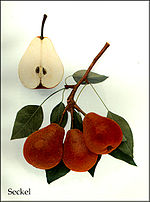Seckel pear
| Seckel pear | |
|---|---|
 | |
| Genus | Pyrus |
| Species | Pyrus communis |
| Hybrid parentage | wild seedling |
| Cultivar | Seckel |
| Origin | Pennsylvania |
The Seckel pear (or sugar pear) is a small, very sweet cultivar of pear believed to have originated in Philadelphia, Pennsylvania.
Cultivar history[edit]

The Seckel is said to be named after the Pennsylvania farmer who first introduced it in the late 18th century.[1] It was one of the varieties planted at Monticello by Thomas Jefferson, who said it "exceeded anything I have tasted since I left France, and equalled any pear I had seen there." His high regard for the Seckel was shared by the eminent horticulturalist A. J. Downing, who rated its flavor above even European pear varieties.[2]
Tree characteristics[edit]
The Seckel pear tree is relatively small, reaching a height of 15-20 feet and width of about 10 feet.[3] It has light grey bark and resembles an apple tree.[4] Its white flowers bloom in mid-Spring.[3] The tree is cold-hardy, frost-resistant, and resistant to fire blight.[4]
Fruit characteristics[edit]
The Seckel is a winter pear, harvested in the fall, which can be stored for about 5 months. The fruit is very sweet and crunchy, with a coarser grain than most European varieties.[5] Compared to most other pears, they are very small, less than 3" in length and width.[4]

